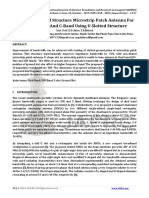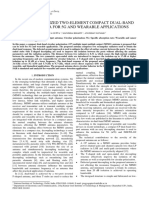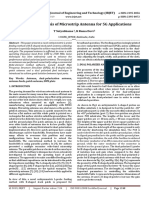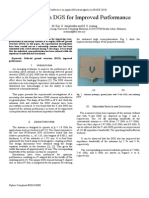PBG Dgs 2
PBG Dgs 2
Uploaded by
Sandip MaityOriginal Title
Copyright
Available Formats
Share this document
Did you find this document useful?
Is this content inappropriate?
Report this DocumentCopyright:
Available Formats
PBG Dgs 2
PBG Dgs 2
Uploaded by
Sandip MaityCopyright:
Available Formats
IEEE MICROWAVE AND WIRELESS COMPONENTS LETTERS, VOL. 15, NO.
2, FEBRUARY 2005
55
Harmonic Suppression With Photonic Bandgap and
Defected Ground Structure for a Microstrip Patch
Antenna
Haiwen Liu, Student Member, IEEE, Zhengfan Li, Xiaowei Sun, Member, IEEE, and Junfa Mao, Senior Member, IEEE
AbstractThis letter presents a microstrip patch antenna integrated with two-dimensional photonic bandgap (PBG) and onedimensional defected ground structure (DGS) jointly in ground
plane. It is demonstrated that application of both PBG and DGS
eliminates the second and third harmonics and improves the return loss level. Moreover, the combination use of PBG and DGS
decreases the occupied area by 70% compared to the conventional
PBG patch antenna.
Index TermsDefected ground structure (DGS), harmonics,
patch antenna, photonic bandgap (PBG).
I. INTRODUCTION
ILTERING is one of the most important technologies in
microwave circuit design. Conventionally, filters are implemented with shunt stubs or stepped-impedance lines, but the
approaches provide a narrow band and a spurious in stopband.
Recently, there has been an increasing interest in studying the
microstrip patch antenna with various periodic structures including photonic bandgap (PBG) [1][4] and defected ground
structure (DGS) [5][7]. For example, a microstrip patch antenna with two-dimensional (2-D) PBG to control harmonic is
reported in [1]. Lin proposed a compact PBG to suppress harmonics for CPW-fed loop-slot antenna [2]. Also, the high-order
harmonics can be reduced by PBG microstrip circuits [3]. Besides, Sung uses a H-shaped DGS to reduce harmonics of patch
antenna [5].
In this letter, based on the microstrip patch antenna with 2-D
PBG described in [1], a one-dimensional (1-D) DGS microstrip
circuit is used to enhance the ability of harmonics suppression.
Moreover, the combination use of PBG and DGS decreases the
occupied area by 70% compared to the conventional PBG patch
antenna.
II. ANTENNA DESIGN AND ANALYSIS
The structure of the microstrip patch antenna with PBG and
mm square
DGS substrate is presented in Fig. 1. A
patch is fabricated on the glass-epoxy substrate with dimensions
Manuscript received April 22, 2004; revised July 28, 2004. The review of this
letter was arranged by Associate Editor J.-G. Ma.
H. Liu, Z. Li, and J. Mao are with the Department of Electronic Engineering, Shanghai Jiaotong University, Shanghai 200030, China (e-mail:
haiwen_liu@hotmail.com; zfli@sjtu.edu.cn).
X. Sun is with Shanghai Institute of Microsystem and Information Technology, Chinese Academy of Sciences, Shanghai 200050, China.
Digital Object Identifier 10.1109/LMWC.2004.842809
Fig. 1. Antenna with PBG and DGS in ground plane.
Fig. 2. Schematics of DGS and PBG microstrip circuits. (a) Structure of 1-D
DGS. (b) Structure of 2-D PBG.
mm and the relative permittivity of
of
4.8. Source signal is fed directly to the antenna by the 50microstrip line with 2.8-mm strip width. The 3 3 circles with
the diameter of 18 mm are etched in the ground plane at the
period of 38 mm. At the same time, 1-D DGS with two unit
cells is etched in the ground plane. The structure is presented
in Fig. 2(a). The 2-D PBG has 4 3 circles in [1] is presented
in Fig. 2(b) while the bottom row circles is replaced by the 1-D
DGS in this letter. Comparison of transmission characteristics
between 1-D DGS and 2-D PBG described in Fig. 2 is given
in Fig. 3. Table I summarizes the results. The selectivity of the
low-pass filter is defined as [8]
(1)
sensitivity in dB/GHz,
3-dB attenuation
where
20-dB attenuation point, and
20-dB stoppoint,
band frequency.
1531-1309/$20.00 2005 IEEE
56
IEEE MICROWAVE AND WIRELESS COMPONENTS LETTERS, VOL. 15, NO. 2, FEBRUARY 2005
mm . The replacement
dimension of 1-D DGS is
decreases the occupied area by 70%. So PBG is used in the 2-D
patch region of the antenna while DGS is used in the 1-D microstrip region of the antenna in this letter.
The return loss of the proposed antenna was simulated by EM
software Ensemble 8.0. The results are shown in Fig. 4 compared to the results in [1]. It is clear from the results that the
resonant frequency (fundamental) of the proposed antenna is
0.9 GHz. Its second and third harmonics (corresponding to 1.8
and 2.7 GHz) were perfectly suppressed. Moreover, the ripples
of the proposed antenna are below 0.5 dB while ripples of the
PBG antenna are below 1 dB. Therefore, the return loss level of
the antenna has improved.
Fig. 3.
Transmission characteristics of PBG and DGS microstrip circuits.
TABLE I
COMPARATIVE STUDY OF THE 2-D DGS AND 1-D PBG MICROSTRIP CIRCUITS
III. CONCLUSION
This letter studies a microstrip patch antenna using PBG
and DGS in ground plane. Simulated results indicate the novel
design is quite effective for the harmonics suppression of
microstrip patch antenna. Moreover, the application of both
PBG and DGS decreases the occupied area by 70% compared
to the conventional PBG patch antenna. The compact antenna
with ultra-low harmonics has potential application future in
next-generation mobile communication system. Also, this letter
is the first report on the combination use of PBG and DGS in
microwave circuit design as we know.
REFERENCES
Fig. 4.
Return loss for the microstrip patch antenna.
As can be seen in Table I, the bandwidth of the rejection band
and the selectivity has increased considerably in 1-D DGS compared to 2-D PBG while the occupied area is reduced dramatimm and the
cally. The dimension of one row circles is
[1] Y. Horri and M. Tsutsumi, Harmonic control by photonic bandgap on
microstrip patch antenna, IEEE Microw. Guided Wave Lett., vol. 9, no.
1, pp. 1315, Jan. 1999.
[2] X. Lin, L. Wang, and J. Sun, Harmonic suppression by photonic
bandgap on CPW-fed loop-slot antenna, Microw. Opt. Tech. Lett., vol.
41, pp. 154156, Apr. 2004.
[3] A. Andrenko, Y. Ikeda, and O. Ishida, Application of PBG microstrip
circuits for enhancing the performance of high-density substrate patch
antenna, Microw. Opt. Tech. Lett., vol. 32, pp. 340344, Mar. 2002.
[4] T. Kim and C. Seo, A novel photonic bandgap structure for low-pass
of wide stopband, IEEE Microw. Guided Wave Lett., vol. 10, no. 1, pp.
1315, Jan. 2000.
[5] Y. Sung, M. Kim, and Y. Kim, Harmonics reduction with defected
ground structure for a microstrip patch antenna, IEEE Antennas Wireless Propag. Lett., vol. 2, no. 8, pp. 111113, Aug. 2003.
[6] I. Chang and B. Lee, Design of defected ground structures for harmonic
control of active microstrip antenna, in Proc. IEEE Antennas Propagation Soc. Int. Symp., vol. 2, CA, Jun. 2002, pp. 852855.
[7] Y. Chung, S. Jeon, and D. Ahn et al., High isolation dual-polarized
patch antenna using integrated defected ground structure, IEEE Microw. Wireless Comp. Lett., vol. 14, no. 1, pp. 46, Jan. 2004.
[8] N. C. Karmakar, Theoretical investigations into binomial distributions
of photonic bandgaps in microstripline structures, Microw. Opt. Tech.
Lett., vol. 33, pp. 191196, May 2002.
You might also like
- Doosan MG400-V Shop ManualDocument618 pagesDoosan MG400-V Shop Manualmarjan43100% (5)
- Service Manual: Model: ADS-2200/2700WDocument106 pagesService Manual: Model: ADS-2200/2700WabrahanNo ratings yet
- Project-Antenna ArrayDocument17 pagesProject-Antenna ArraysushantNo ratings yet
- FMX Volvo PDFDocument2 pagesFMX Volvo PDFmr.bounce100% (1)
- Programing ASiMon V3 G2 enDocument413 pagesPrograming ASiMon V3 G2 enAssis NunesNo ratings yet
- Dual-Frequency Folded Dipole Antenna WithDocument2 pagesDual-Frequency Folded Dipole Antenna WithManoj Kumar MeshramNo ratings yet
- A Uniplanar Compact Photonic-Bandgap (UC-PBG)Document6 pagesA Uniplanar Compact Photonic-Bandgap (UC-PBG)Bhagyalaxmi BeheraNo ratings yet
- Harmonics Reduction With DGS For A Micro Strip Patch AntennaDocument3 pagesHarmonics Reduction With DGS For A Micro Strip Patch AntennaMusfirah HilmiNo ratings yet
- A Microstrip Patch Antenna Using Novel Photonic Band-Gap StructuresDocument4 pagesA Microstrip Patch Antenna Using Novel Photonic Band-Gap StructuresluckychandaniNo ratings yet
- Design of Compact Printed Antenna For Umts & Wimax ApplicationsDocument4 pagesDesign of Compact Printed Antenna For Umts & Wimax ApplicationsIJERDNo ratings yet
- Broadband Planar Antennas For Mobile Communications Base StationsDocument8 pagesBroadband Planar Antennas For Mobile Communications Base StationsKhaled Abou ElseoudNo ratings yet
- On The Design of Compact Broadband Gap-Coupled Microstrip Patch Antenna With PBGDocument4 pagesOn The Design of Compact Broadband Gap-Coupled Microstrip Patch Antenna With PBGzeynepleyNo ratings yet
- High Gain of C Shape Slotted Microstrip Patch Antenna For Wireless SystemDocument3 pagesHigh Gain of C Shape Slotted Microstrip Patch Antenna For Wireless SystemAzie BasirNo ratings yet
- Design of Square Miniaturized L Band Fractal AntennaDocument6 pagesDesign of Square Miniaturized L Band Fractal AntennaIJMTERNo ratings yet
- Design A Dual-Band Microstrip Antenna For Wireless (GPS) ApplicationDocument3 pagesDesign A Dual-Band Microstrip Antenna For Wireless (GPS) ApplicationSweatha Manju KNo ratings yet
- A Compact Dual Wideband Bandpass Filter For Automotive Radar (AR) and 5G Millimeter-Wave (Mmwave) ApplicationsDocument9 pagesA Compact Dual Wideband Bandpass Filter For Automotive Radar (AR) and 5G Millimeter-Wave (Mmwave) ApplicationsThierno Amadou Mouctar BaldeNo ratings yet
- Antena Slot HDocument5 pagesAntena Slot HRakhmatTeguhNo ratings yet
- Performance Analysis of Microstrip Patch Antenna by Varying Slot Size For UMTS ApplicationDocument5 pagesPerformance Analysis of Microstrip Patch Antenna by Varying Slot Size For UMTS Applicationsiva1427No ratings yet
- TCPMT 2012 2217341Document5 pagesTCPMT 2012 2217341ppowerpower30No ratings yet
- A Design of Rectangular Linear Polarized Microstrip Patch Antenna at 1 GHZDocument3 pagesA Design of Rectangular Linear Polarized Microstrip Patch Antenna at 1 GHZdhvbkhnNo ratings yet
- Frequency Response Estimation of 1.3 Μm Waveguide Integrated Vertical PIN Type Ge-On-Si Photodetector Based on the Analysis of Fringing Field in Intrinsic RegionDocument6 pagesFrequency Response Estimation of 1.3 Μm Waveguide Integrated Vertical PIN Type Ge-On-Si Photodetector Based on the Analysis of Fringing Field in Intrinsic Regionanushpamathi SundararajanNo ratings yet
- Antenna Miniaturization Techniques For Wireless ApplicationsDocument5 pagesAntenna Miniaturization Techniques For Wireless ApplicationsIAEME PublicationNo ratings yet
- Design of Microstrip Antenna For C-Band FrequencyDocument9 pagesDesign of Microstrip Antenna For C-Band FrequencyCampaigns Of HistoryNo ratings yet
- A Wide Band Slotted Microstrip Patch Antenna For Future 5G PDFDocument5 pagesA Wide Band Slotted Microstrip Patch Antenna For Future 5G PDFdannyNo ratings yet
- Size Miniaturization and Isolation Enhancement of Two-Element Antenna For Sub-6 GHZ ApplicationsDocument9 pagesSize Miniaturization and Isolation Enhancement of Two-Element Antenna For Sub-6 GHZ ApplicationscgakalyaNo ratings yet
- Compact and Low-Cost 3-D Printed Antennas Metalized Using Spray-Coating Technology For 5G Mm-Wave Communication SystemsDocument5 pagesCompact and Low-Cost 3-D Printed Antennas Metalized Using Spray-Coating Technology For 5G Mm-Wave Communication Systemsritu guravNo ratings yet
- A Modified Quasi-Yagi Antenna Fed by A Microstrip LineDocument3 pagesA Modified Quasi-Yagi Antenna Fed by A Microstrip LineNguyen Xuan HieuNo ratings yet
- I Jcs It 2012030614Document3 pagesI Jcs It 2012030614Clark Jackson MartínezNo ratings yet
- A Dual-Band Wearable Conformal Antenna Based On ArDocument8 pagesA Dual-Band Wearable Conformal Antenna Based On Armanendra lakraNo ratings yet
- Defective Ground Structure Microstrip Patch Antenna For ISM, Wi-MAX and C-Band Using U Slotted StructureDocument8 pagesDefective Ground Structure Microstrip Patch Antenna For ISM, Wi-MAX and C-Band Using U Slotted StructureIJAFRCNo ratings yet
- A Low-Profile Dual-Polarized Dipole Antenna Using Wideband AMC ReflectorDocument6 pagesA Low-Profile Dual-Polarized Dipole Antenna Using Wideband AMC ReflectorVijeta Diwan.21DR0213No ratings yet
- Design of Compact Antenna With Modified Ground Plane For Ultra Wide Band CommunicationDocument4 pagesDesign of Compact Antenna With Modified Ground Plane For Ultra Wide Band CommunicationInternational Journal of Application or Innovation in Engineering & ManagementNo ratings yet
- RJ Synopsis Antenna RevisedDocument7 pagesRJ Synopsis Antenna RevisedragvshahNo ratings yet
- 16 PGupta RRST 3 2022 PP 321-326-RevDocument6 pages16 PGupta RRST 3 2022 PP 321-326-RevPhan PhúcNo ratings yet
- IRJET Design and Analysis of MicrostripDocument4 pagesIRJET Design and Analysis of MicrostripSoniya SonawaneNo ratings yet
- Magnetic DraDocument5 pagesMagnetic DramountyzoaNo ratings yet
- 1 - 220-320 GHZ Hemispherical Lens Antennas UsingDocument8 pages1 - 220-320 GHZ Hemispherical Lens Antennas UsingBilal MalikNo ratings yet
- A Small Dual Band 28 38 GHZ Elliptical A PDFDocument5 pagesA Small Dual Band 28 38 GHZ Elliptical A PDFDrAbdallah NasserNo ratings yet
- Band-Notched UWB Antenna Incorporating A Microstrip Open-Loop ResonatorDocument4 pagesBand-Notched UWB Antenna Incorporating A Microstrip Open-Loop ResonatorarbtepNo ratings yet
- Rectangular Patch AntennaDocument81 pagesRectangular Patch AntennaSulaim King X100% (2)
- Design and Fabrication of DGSDocument4 pagesDesign and Fabrication of DGSडाँ सूर्यदेव चौधरीNo ratings yet
- Design of A Slot Antenna For Future 5G Wireless Communication SystemsDocument3 pagesDesign of A Slot Antenna For Future 5G Wireless Communication Systemsphathoang2001No ratings yet
- My Jases PaperDocument9 pagesMy Jases PaperZainab Baba mallamNo ratings yet
- V5i3 Ijertv5is030037Document5 pagesV5i3 Ijertv5is030037Ramya RNo ratings yet
- Design & Development of Brick Wall Shaped Microstrip Miniaturized Ultra-Wide Band Patch Antenna For Fifth Generation (5G)Document6 pagesDesign & Development of Brick Wall Shaped Microstrip Miniaturized Ultra-Wide Band Patch Antenna For Fifth Generation (5G)Arnob TanjimNo ratings yet
- Inset Fed Rectangular PDFDocument5 pagesInset Fed Rectangular PDFVijaya ShreeNo ratings yet
- Circular Shape Antenna Embedded With B-Shape Slot For UWB ApplicationsDocument4 pagesCircular Shape Antenna Embedded With B-Shape Slot For UWB ApplicationsInnovative Research PublicationsNo ratings yet
- The Effect of Dielectric Loss Tangent On Radiation Characteristics of Co-Axial Feed Rectangular Patch AntennaDocument4 pagesThe Effect of Dielectric Loss Tangent On Radiation Characteristics of Co-Axial Feed Rectangular Patch AntennaInnovative Research PublicationsNo ratings yet
- Characteristics of A Corrugated Tapered Slot Antenna With Dielectric Rod and Metallic Re EctorDocument4 pagesCharacteristics of A Corrugated Tapered Slot Antenna With Dielectric Rod and Metallic Re Ectorma_ba1No ratings yet
- Performance Analysis of Microstrip Patch Antenna Using Coaxial Probe Feed TechniqueDocument3 pagesPerformance Analysis of Microstrip Patch Antenna Using Coaxial Probe Feed TechniqueInternational Jpurnal Of Technical Research And Applications100% (1)
- Novel Planar Wideband Omni-Directional Quasi Log-Periodic AntennaDocument4 pagesNovel Planar Wideband Omni-Directional Quasi Log-Periodic Antennamano012No ratings yet
- 8.design of An S-Band Rectangular Microstrip Patch AntennaDocument8 pages8.design of An S-Band Rectangular Microstrip Patch Antennasrinivas08427No ratings yet
- Triple Band Notched DG-CEBG Structure Based UWB MIMO/Diversity AntennaDocument17 pagesTriple Band Notched DG-CEBG Structure Based UWB MIMO/Diversity AntennamahiNo ratings yet
- The Design of Miniaturized Printed Wire Antennas Using Double-Layer Periodic MetallizationDocument4 pagesThe Design of Miniaturized Printed Wire Antennas Using Double-Layer Periodic MetallizationMohamed Mahmud MostafaNo ratings yet
- CST Studio Suite 2015Document4 pagesCST Studio Suite 2015hmalrizzoNo ratings yet
- Microstrip Patch Antenna at 28 GHZ For 5Document3 pagesMicrostrip Patch Antenna at 28 GHZ For 5Abdulwahab JarboaNo ratings yet
- Antenna With DGS For Improved PerformanceDocument4 pagesAntenna With DGS For Improved PerformanceMehrdad ShirianNo ratings yet
- International Journal of Electronics and Communications: Prabhu Palanisamy, Malarvizhi SubramaniDocument10 pagesInternational Journal of Electronics and Communications: Prabhu Palanisamy, Malarvizhi SubramaniSrikar DNo ratings yet
- DGS Based Monopole Circular-Shaped Patch Antenna FDocument13 pagesDGS Based Monopole Circular-Shaped Patch Antenna Fsreelakshmi.ece eceNo ratings yet
- JEDS2017Document7 pagesJEDS2017Tithi Anjuman HoqueNo ratings yet
- DMS DGS FilterDocument20 pagesDMS DGS Filtersam100% (1)
- Continuously Tunable Delay Line Based On SOI Tapered Bragg GratingsDocument6 pagesContinuously Tunable Delay Line Based On SOI Tapered Bragg GratingsAlexanderNo ratings yet
- Designand Analysisofawideband PDFDocument5 pagesDesignand Analysisofawideband PDFSandip MaityNo ratings yet
- On The Possibility of A Perfect Power Combiner: Sailing He and Kexin LiuDocument6 pagesOn The Possibility of A Perfect Power Combiner: Sailing He and Kexin LiuSandip MaityNo ratings yet
- PHD Shortlist - Catagory A, B, CDocument3 pagesPHD Shortlist - Catagory A, B, CSandip MaityNo ratings yet
- 03 0203151 King MDocument19 pages03 0203151 King MSandip MaityNo ratings yet
- Low-Profile On-Board Antenna With A Broad Beam Based On Three-Current ModelDocument12 pagesLow-Profile On-Board Antenna With A Broad Beam Based On Three-Current ModelSandip MaityNo ratings yet
- Metamaterial Antenna Arrays For Improved Uniformity of Microwave Hyperthermia TreatmentsDocument12 pagesMetamaterial Antenna Arrays For Improved Uniformity of Microwave Hyperthermia TreatmentsSandip MaityNo ratings yet
- Progress in Electromagnetics Research, Vol. 141, 17-32, 2013Document16 pagesProgress in Electromagnetics Research, Vol. 141, 17-32, 2013Sandip MaityNo ratings yet
- Res Pre June2016 v2Document2 pagesRes Pre June2016 v2Sandip MaityNo ratings yet
- Blind Direction of Arrival Estimation of Coherent Sources Using Multi-Invariance Property X. Zhang, J. Yu, G. Feng, and D. XuDocument15 pagesBlind Direction of Arrival Estimation of Coherent Sources Using Multi-Invariance Property X. Zhang, J. Yu, G. Feng, and D. XuSandip MaityNo ratings yet
- Progress in Electromagnetics Research, Vol. 133, 91-115, 2013Document25 pagesProgress in Electromagnetics Research, Vol. 133, 91-115, 2013Sandip MaityNo ratings yet
- A Simple Alternative For Beam Reconfiguration of Array Antennas F. AresDocument14 pagesA Simple Alternative For Beam Reconfiguration of Array Antennas F. AresSandip MaityNo ratings yet
- A Compact Pi-Structure Dual Band Transformer: Progress in Electromagnetics Research, PIER 88, 121-134, 2008Document14 pagesA Compact Pi-Structure Dual Band Transformer: Progress in Electromagnetics Research, PIER 88, 121-134, 2008Sandip MaityNo ratings yet
- Graphene-Based Infrared Lens With Tunable Focal Length: Yan Xiu Li, Fan Min Kong, and Kang LiDocument8 pagesGraphene-Based Infrared Lens With Tunable Focal Length: Yan Xiu Li, Fan Min Kong, and Kang LiSandip MaityNo ratings yet
- Progress in Electromagnetics Research, PIER 95, 199-218, 2009Document20 pagesProgress in Electromagnetics Research, PIER 95, 199-218, 2009Sandip MaityNo ratings yet
- Progress in Electromagnetics Research, PIER 95, 309-327, 2009Document19 pagesProgress in Electromagnetics Research, PIER 95, 309-327, 2009Sandip MaityNo ratings yet
- The Relativistic Proper-Velocity Transformation Group: Progress in Electromagnetics Research, PIER 60, 85-94, 2006Document10 pagesThe Relativistic Proper-Velocity Transformation Group: Progress in Electromagnetics Research, PIER 60, 85-94, 2006Sandip MaityNo ratings yet
- Progress in Electromagnetics Research, Vol. 121, 225-247, 2011Document23 pagesProgress in Electromagnetics Research, Vol. 121, 225-247, 2011Sandip MaityNo ratings yet
- Progress in Electromagnetics Research, PIER 95, 19-38, 2009: Corresponding Author: F. Malek (Mfareq@unimap - Edu.my)Document20 pagesProgress in Electromagnetics Research, PIER 95, 19-38, 2009: Corresponding Author: F. Malek (Mfareq@unimap - Edu.my)Sandip MaityNo ratings yet
- Homelite String Trimmer Parts Manual SX135 String Trimmer UT 20601 CDocument12 pagesHomelite String Trimmer Parts Manual SX135 String Trimmer UT 20601 CTomas StrNo ratings yet
- ICT - Computer System Servicing 9 Quarter 1 - Module 5: Lesson 2:performing Computer Operation (PCO) - Input Data Into ComputerDocument30 pagesICT - Computer System Servicing 9 Quarter 1 - Module 5: Lesson 2:performing Computer Operation (PCO) - Input Data Into ComputerRose GutierrezNo ratings yet
- Textbook Energy Vampires How To Protect Yourself From Toxic People With Narcissistic Tendencies Tony Sayers Ebook All Chapter PDFDocument53 pagesTextbook Energy Vampires How To Protect Yourself From Toxic People With Narcissistic Tendencies Tony Sayers Ebook All Chapter PDFhenry.sinegal624100% (18)
- Sop For AdminDocument12 pagesSop For AdminSaurabh SinghNo ratings yet
- Exective Summary: The Project Is Basically The Launch of Lipton Ice Tea Under Unilever Pakistan. ItDocument115 pagesExective Summary: The Project Is Basically The Launch of Lipton Ice Tea Under Unilever Pakistan. ItRashid ShahzadNo ratings yet
- Parameters List For GSM (Huawei)Document18 pagesParameters List For GSM (Huawei)mosesNo ratings yet
- Tourism ProjectDocument80 pagesTourism ProjectAyush TiwariNo ratings yet
- Vikta102 Ecl Modbus OpcDocument10 pagesVikta102 Ecl Modbus OpcTobias AngererNo ratings yet
- EDI MessagesDocument5 pagesEDI MessagesLu VanderhöffNo ratings yet
- Solucion Taking Care of The PlanetDocument2 pagesSolucion Taking Care of The PlanetPAOLANo ratings yet
- 5.NAMARCO Vs Associated Finance Company, G.R. No. L-20886Document3 pages5.NAMARCO Vs Associated Finance Company, G.R. No. L-20886Elizabeth Jade D. CalaorNo ratings yet
- Error Tolerant AdderDocument21 pagesError Tolerant AdderGnrajesh RajeshNo ratings yet
- 1.1.2, 1.1.3, 1.1.4 Topical PastPapers ImagesDocument32 pages1.1.2, 1.1.3, 1.1.4 Topical PastPapers ImagesUzair NadeemNo ratings yet
- Refractory EngineeringDocument11 pagesRefractory EngineeringJignesh TrivediNo ratings yet
- DTU New Syllabus For MEDocument83 pagesDTU New Syllabus For MEHari SreyasNo ratings yet
- Presentation Pengetahuan Bahanapi PelincirDocument58 pagesPresentation Pengetahuan Bahanapi PelincirRoslina HassanNo ratings yet
- Safety Data Sheet: Glucotain ClearDocument18 pagesSafety Data Sheet: Glucotain ClearJulián David de la CruzNo ratings yet
- English For TourismDocument98 pagesEnglish For Tourismsonia80% (5)
- Negotiation TechniquesDocument11 pagesNegotiation TechniquesNadina ŞtefaniaNo ratings yet
- Simple Styrofoam Hot Wire CutterDocument14 pagesSimple Styrofoam Hot Wire Cuttermarius_danila8736100% (2)
- Rural Marketing Initiatives by Companies in IndiaDocument86 pagesRural Marketing Initiatives by Companies in IndiaAkash Rajput92% (37)
- Morita Fire Fighting Vehicle Fire Fighting Turn Table Ladder Truck Model Mlf4-30Document3 pagesMorita Fire Fighting Vehicle Fire Fighting Turn Table Ladder Truck Model Mlf4-30มั่งคั่ง คุรุภัณฑ์เซอร์วิส เครื่องตัดถ่างหมอนลมยกรถNo ratings yet
- 5G RF Transceiver MarketDocument6 pages5G RF Transceiver MarketSara SwasNo ratings yet
- Elena BacaDocument5 pagesElena BacaZewa Miteu0% (1)
- ADC Section 4 Commuter Facilities Design Requirements and Checklist FormsDocument128 pagesADC Section 4 Commuter Facilities Design Requirements and Checklist FormsYam BalaoingNo ratings yet
- A Comparative Study On Digital Marketing Over Traditional MarketingDocument10 pagesA Comparative Study On Digital Marketing Over Traditional MarketingMd AdilNo ratings yet











































































































